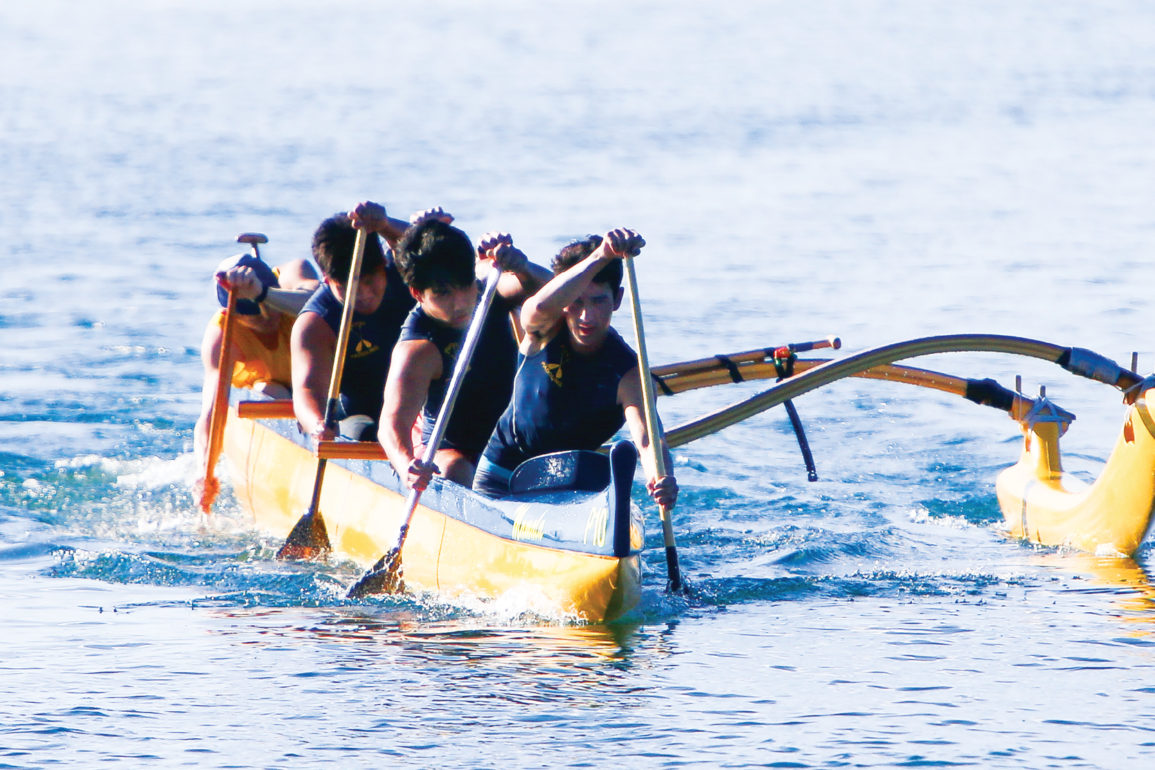Story by Mindy Pennybacker ’70
Photos by Kristen Collat
At Ala Moana Beach Park during winter, one can witness a frequent, counterintuitive sight: heavy outrigger canoes traveling on land, gliding and bobbing atop multiple legs and straining shoulders. The bearers are members of Punahou’s competitive paddling team, who carry the 40-foot-long wa‘a (canoes) from the park’s canoe halau across the road to the ocean at Magic Island for every practice or race and back again. At the end of the season, the students load the canoes into the school’s trailer for the return trip to Punahou, where they unload them for safe storage in a canoe halau on Rocky Hill.
Since the program’s founding in 1979, Punahou’s paddlers have won many Interscholastic League of Honolulu (ILH) and state championship titles. The nine-team program includes multiple boys and girls teams at both the varsity and JV levels, and a mixed varsity I team made up of three boys and three girls. This unique combination of boys and girls competing on the same team is only offered in two other ILH sports – precision air riflery and sailing.
Among Punahou’s teams in the 2016 – 2017 season, boys varsity I won their second consecutive ILH and third consecutive state titles, and the mixed varsity, boys JV I, girls varsity I, JV I and JV II teams all took ILH first places.
But as with most competitive sports, although one gives one’s best to win, the true meaning and rewards of canoe racing don’t depend on coming in first.
Working Together
Out in the water, the six-person teams in action make a classic, timeless sight that harkens back to the old Hawai‘i of drawings, etchings and songs: the long, streamlined canoes slicing through the water against the open horizon, the paddlers reaching out and pulling deeply in unison, using their backs as well as arms, while the steersman in the stern calls out directions, encouragement and, always, the rhythm of the strokes.
Six people pulling together as one: It’s the essence of teamwork. But it’s also only part of the picture, for outrigger canoe paddling at Punahou is not just a sport. The training connects practitioners to the ocean environment and Hawaiian culture, fosters community spirit and provides practical life skills, according to girls coach Becky Fardal, boys coach Rocky Higgins ’68 and emeritus coaches Marion Lyman- Mersereau ’70 and Reney Ching.
“Our paddling coaches have truly embraced the ‘coach as educator’ model of Punahou Athletics,” says Academy Assistant Principal James Kakos. “They pay just as much attention to the social and emotional well-being of student athletes as they do to the results in the water.”
“The paddlers learn how to laulima (cooperate) with each other not only in paddling but also carrying the boats,” said Lyman-Mersereau, grade 8 Social Studies teacher. They also learn how to care for their equipment, including how to lash and tie the ropes that secure the joints of the ‘iako (outrigger arms) and ama (float at the ends of the arms).
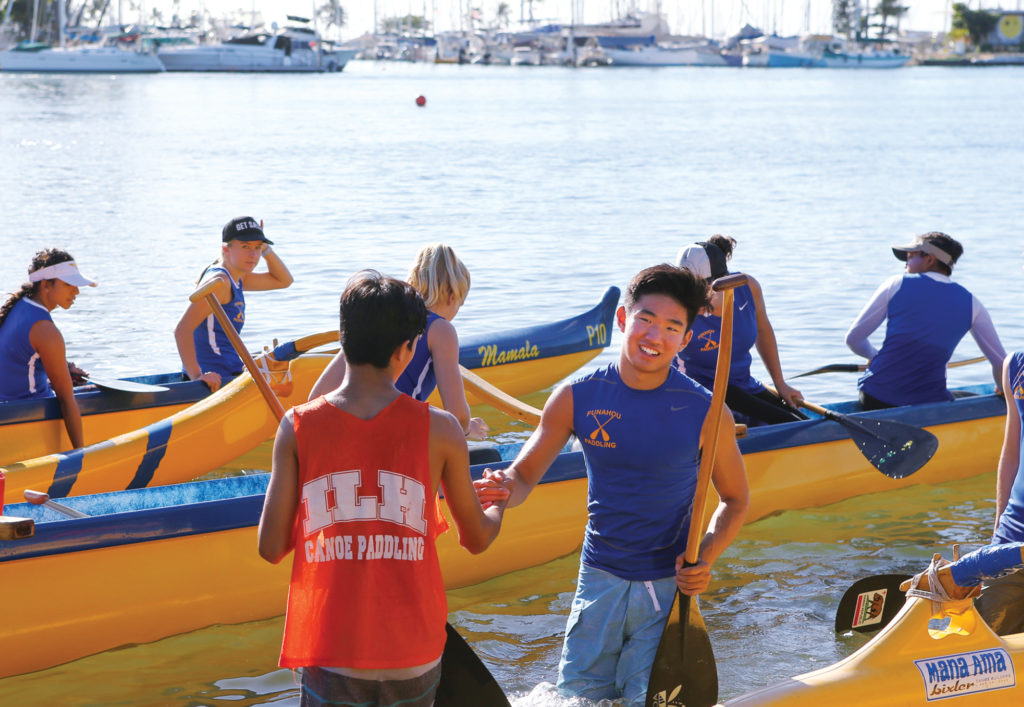
It can take anywhere from 12 to 20 students to carry one of the 400-pound canoes, said Higgins who is also a PE teacher at Punahou. At Magic Island, they launch the canoe into the water down a cement ramp. “Ideally, they pass the wa‘a hand-overhand gently, conveyor-belt style,” said Higgins.
The canoes cost $7,000 – $8,000 each, and repairing them is expensive, according to Ching who served as head JV coach and oversaw the equipment. “One of my most heartfelt accomplishments was to finally get a home for our canoes on campus,” says Ching, operations manager at the school cafeteria.
“Above all, Hawaiian culture dictates that the canoes are treated with respect and care,” Lyman-Mersereau said. “They are sacred vessels that have each been blessed with names.”
Although the contemporary craft raced by Punahou and other schools are molded in fiberglass, they are the descendants and heirs of traditional Hawaiian wa‘a carved from koa tree trunks. “Probably the most important piece of knowledge that we need to reinforce is that the fiberglass canoes evolved from canoes that came from highly nurtured, living koa trees,” Higgins said. “The living spirit of the tree does not die with the harvesting, but continues to reside in the koa canoe, giving it life and purpose.”
“Providing for transportation and fishing, canoes were essential to daily life and survival in Hawai‘i,” Higgins said. “That’s why you never see a decal on a koa canoe.”
The Races
ILH paddling teams practice and race in the ocean, learning to read and cope with winds, currents and waves. It’s distance racing, requiring endurance: The shortest course is 3 miles, going from Magic Island to the buoys at Kewalo Basin and back; the longest, 5.5 miles, stretches from Magic Island down to Kewalos, up to the Kapahulu Groin or “Walls” in Waikiki, and then back down to the finish line at Magic Island.
The HHSAA State Paddling Championships, which began in 2002, are half-mile regatta sprints on a quarter-mile course in Ke‘ehi Lagoon, and every two years the race site alternates between Hilo Bay on Hawai‘i Island and Kahului Harbor on Maui.
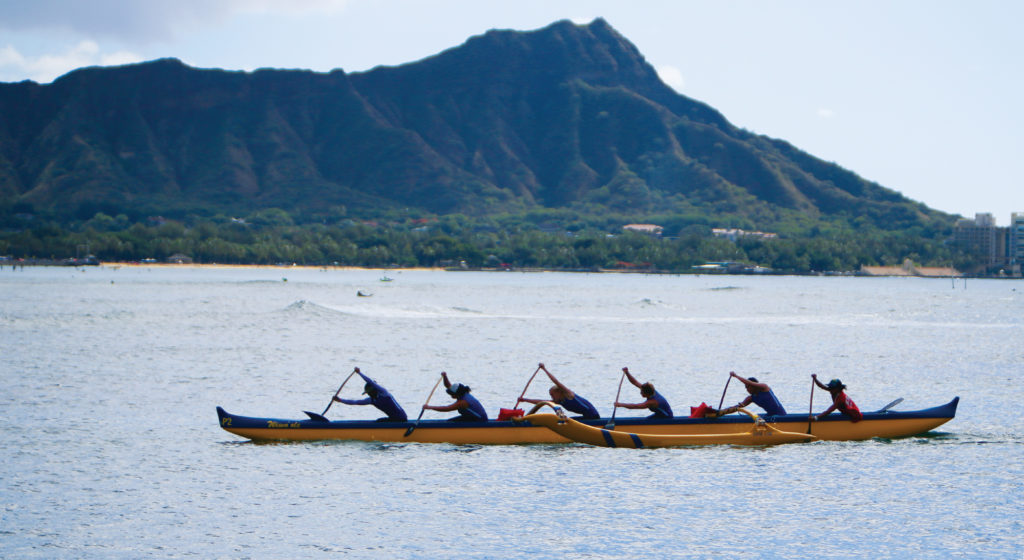
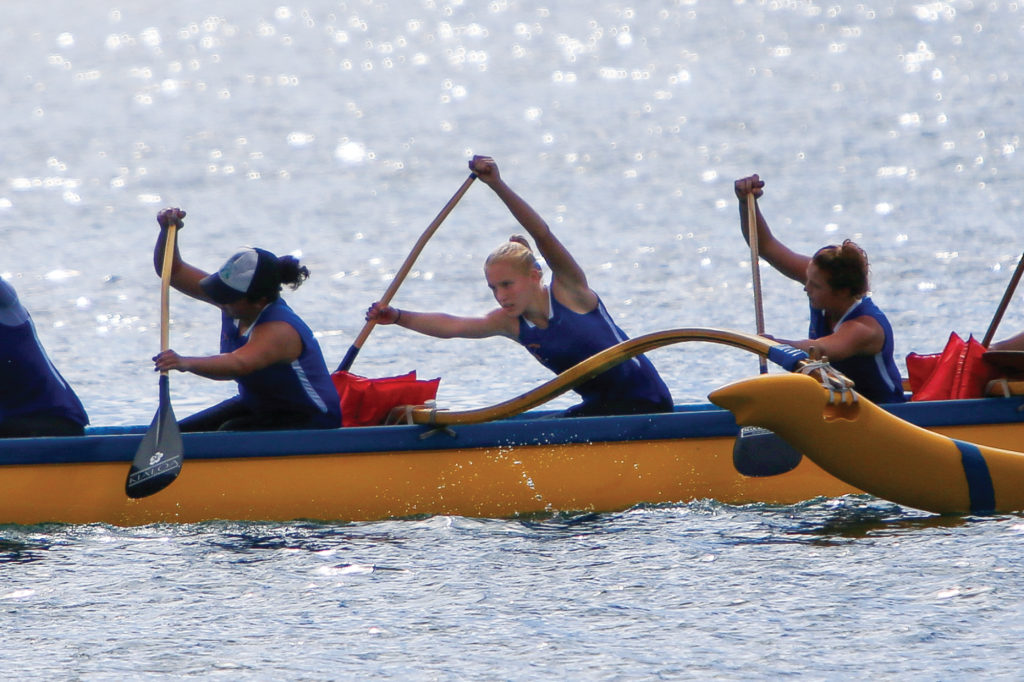
Before races, the boats are weighed; they must be a minimum of 400 pounds. “If a canoe is too light, we have to add lead weights,” Higgins said. “You want to be pono.”
In the Hawaiian tradition of sharing resources, Punahou lends its canoes to schools, such as those that are just starting a program, that don’t have Malia molds.
The only other equipment is a paddle, and by the time team members get to varsity level, they usually have invested in one of their own. When she paddled for Hui Nalu Canoe Club, Lyman-Mersereau recalled, “You practiced with a heavy paddle and then on race day they gave you a racing paddle, and what a difference! It felt feather-light.”
Above all, Hawaiian culture dictates that the canoes are treated with respect and care. They are sacred vessels that have each been blessed with names.
The Practices
As vital as paddling practice are workouts such as long-distance running and swimming, the coaches said, which condition the mind as well as the body for endurance and strength. That’s because paddling is “repetitive, tedious, monotonous work,” Lyman-Mersereau said.
“It’s like digging a ditch,” Higgins added.
“But sometimes you see dolphins,” Lyman-Mersereau said, her blue eyes lighting up.
With more than 100 students participating in the various teams, practices at Magic Island are an elaborate circuit. While some teams are out in the canoes, those who are waiting do run/swim gauntlets for cardio endurance, and pushups, pullups and situps for muscular strength. Outside of school practice, students exercise on their own, including yoga, Ultimate Frisbee and biathlons.
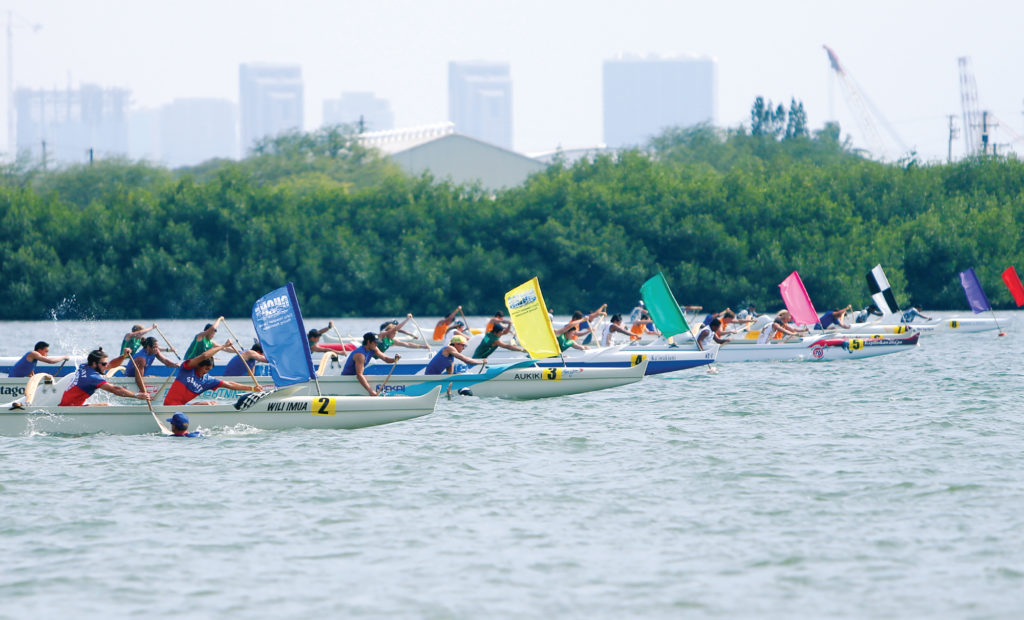
Making the Team
Nowadays, more than a majority of Punahou paddlers also participate in extracurricular paddling for canoe clubs in the season that runs from April through August. While the coaches credit much of Punahou’s recent success to having kids who have paddled together in the summer, no prior experience is required in order to make a team. “At the first meeting for tryouts, I’d tell them, we’ll teach you how,” Lyman-Mersereau said. “I’d tell them I actually prefer first-time paddlers because I don’t have to correct any bad habits.”
If a candidate says he or she can’t run or can’t swim, the coaches help them draw up an equivalent regimen. “I’d tell them, you just have to prove to me, in tryouts, you’ve got the mental toughness for long distance,” Lyman-Mersereau said.
Because it’s difficult to keep one’s focus in the long, hard canoe slogs, a positive attitude is paramount, she added. For example, if a steersman calls out “Don’t give up,” she’ll correct them: “The crew probably wasn’t thinking of giving up until you mentioned it!”
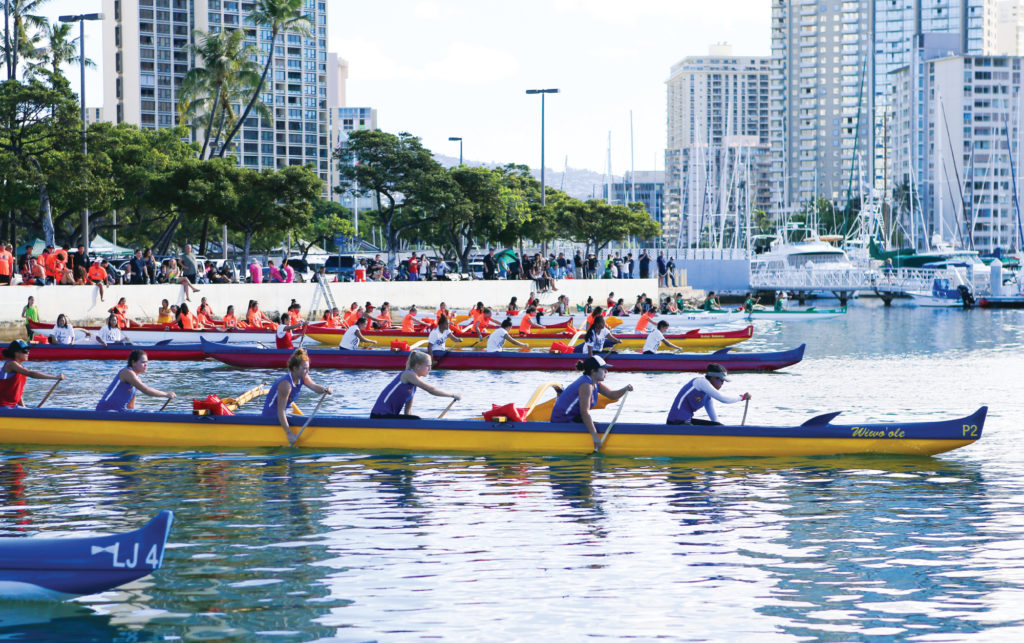
Ho‘ohau‘oli: Have Fun
As the old Hawaiians showed in their devotion to surfing – with bodies, boards and canoes – everyone who gets out and enjoys the sea and its waves is a winner.
“Any chance we get, the paddlers practice in the waves off of Waikiki and Ala Moana to hone their surfing skills,” Fardal said. The coaches, she added, work with all the steersmen and steerswomen “on the motion of the ocean and being able to read the water and waves.” They’ll guide the paddlers from the back of the canoe or in a motorboat following behind.
All this takes spirit as well as skill, and both were amply demonstrated in an exciting girls race this year. “As they turned around the buoy and were on the return leg, the steerswoman knew how to work with the ocean swells, and they came from behind and passed the lead boat to win,” Fardal said.
Lyman-Mersereau makes it easy to understand how the joy of paddling outpaces the grind: “When you pull together in perfect rhythm, going fast, working hard but refreshed by wind and spray, the heavy canoe leaps forward and the magic happens. It feels effortless, weightless, like breathing, like flying.”
Mindy Pennybacker ’70 is a reporter for the Honolulu Star-Advertiser.
Children of Malia
All outrigger canoes racing today are fiberglass molds of the Malia, an outstandingly fast koa canoe designed by James Takeo Yamasaki in 1940 that was raced by the Outrigger Canoe Club and then by the Waikiki Surf Club, which used it from 1948 – 1988.
In order to qualify for ILH competition, “every boat has to be a Malia mold,” Coach Rocky Higgins ’68 explained.
Punahou has 10 canoes, each bearing a name that’s filled with meaning. The first four on the list below were named by the Waikiki Surf Club, from which the school purchased them. The last two, Kupono and Wiwo‘ole, were the last two canoes made from the original Malia mold.
- Makua Jr.: Named for Blue Makua, a well-known beach boy
- Lanakila ‘ekolu: Victory number three, named after an earlier koa canoe owned by Waikiki Surf Club
- Kini II: Named after a Waikiki Surf Club coach in the 1970s
- Mamala: The name of the area teams paddle in, stretching from Diamond Head to Barbers Point
- Malama o ke kai: Care for the ocean
- Malama ‘oiwi: Care for the ancestors
- Ho‘ohau‘oli: Have fun
- Kolohe o ke kai: Rascal of the ocean
- Kupono: Honesty
- Wiwo‘ole: Courage

